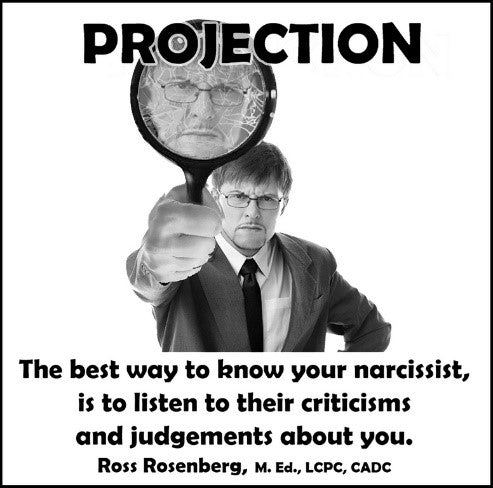Taken from Ross Rosenberg's Book, The Codependency Revolution: Fixing What Was Always Broken.
PROJECTION
Projection is a defense mechanism that invisibly and unconsciously protects the narcissist from understanding their true shame-dominated and self-hating selves. Such an unconscious shame response is directly linked to the unexpressed and buried rage toward one or both of their parents who could not or would not love, respect, care, and protect them, especially as a vulnerable child. In addition, this protective amnesia wards off the recollection of the horrendous abuse, neglect, abandonment, and deprivation to which they were unsympathetically subjected.
The defense mechanism projection also explains the inner workings of a narcissistic injury. Narcissists project their self-hatred, self-judgment, and unexpressed rage over their unmitigated child abuse onto a safer person: the offending and supposedly injuring person. Projection conveniently shifts, places, and diverts all of what the narcissist hates about themselves, which is too painful and unsafe to recollect, onto the person they misperceived as hurting them.
Through the projection or placement of such untapped vindictive rage onto another vulnerable person, they delude themselves as finally being strong enough to stand up to their enemies, which are themselves and the cause of their childhood trauma. Blaming and punishing others successfully protects them from what their fragile minds cannot accept. Feeling bad, broken, and/or never good enough as they did as a child is not an option for the personality disordered narcissist.
Narcissistic Injuries
In all forms of a narcissistic injury, the pathological narcissist perceives the injury as so severe that they lose control over their reactive emotions and consequently punish the offender. In the current professional vernacular, these events are characterized as emotional dysregulation. However, unbeknownst to the activated narcissist, the surface rage, attribution of blame, and decision to retaliate are controlled by disassociated or unconsciously buried core shame.
A narcissistic injury occurs when narcissists reflexively react to perceived criticism, embarrassment, judgment, boundaries, or attempts to be held accountable. Often, such a reaction takes the shape of aggravated anger or rage, a compulsion to retaliate immediately, or a covert strategy to mute the rage while planning a more effective time to punish and retaliate.
Such reactive fits of punitive rage also occur when a person does not accommodate a narcissist’s insatiable need for admiration, special privileges, praise, etc. In the cases of a person with borderline personality disorder, the injury shows up when the perceived wrong-doing or insensitivity is greatly over-amplified. At the same time, paranoid-like thought processes drive the need to believe malicious or purposeful intent.
Although the hair-trigger reaction of a narcissistic injury emboldens and seemingly protects the narcissist, it is only temporary. It will eventually fall off like a loosely fitted bandage, exposing the underlying core shame wound. This is when defense mechanisms kick back into action and once again divert the narcissists away from their core shame and toward their grandiose and entitled, dissociated selves. Because they are unaware of and can’t take responsibility for their harmful reactions, they hunker down in their “blame others” positions. Except for individuals suffering from BPD, they often refuse to acknowledge the harm they caused or apologize for their wrongdoings.
Click HERE for more information about
Ross and Self-Love Recovery Insititute



0 comments